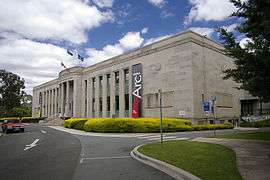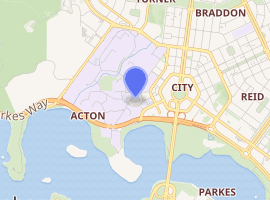Australian Institute of Anatomy
The Australian Institute of Anatomy was a natural history museum and medical research institute that was founded in 1931 and disbanded in 1985. The Institute's heritage-listed building, located in Acton, Canberra, in the Australian Capital Territory, Australia, has been occupied by the National Film and Sound Archive since October 1984. The building was added to the Commonwealth Heritage List on 22 June 2004.[1]
| Australian Institute of Anatomy (former) building | |
|---|---|
 The National Film and Sound Archive is now located in the former Australian Institute of Anatomy building | |

| |
| Alternative names | National Film and Sound Archive building |
| General information | |
| Status | Complete |
| Architectural style |
|
| Location | McCoy Cct, Acton, Canberra, Australian Capital Territory |
| Country | Australia |
| Coordinates | 35°16′59″S 149°07′16″E |
| Current tenants | National Film and Sound Archive |
| Renovated | 1984; 1999; 2019 |
| Owner | Commonwealth of Australia |
| Technical details | |
| Material | Masonry; Hawkesbury sandstone |
| Floor count | 3 |
| Design and construction | |
| Other designers | E. Bruce (landscape) |
| Official name | Institute of Anatomy (former), McCoy Cct, Acton, ACT, Australia |
| Type | Listed place |
| Criteria | A., B., D., F., G. |
| Designated | 22 June 2004 |
| Reference no. | 105351 |
| References | |
| [1] | |
The Australian Institute of Anatomy was established in October 1931 following the relocation of the National Museum of Australian Zoology from Melbourne to Canberra. Amongst its functions were a natural history museum and research into human nutrition. The Institute was abolished in December 1985.[2]
Description
The National Film and Sound Archive (also known as ScreenSound Australia and formerly the Institute of Anatomy) consists of the main building, its surrounds and the former director's residence. The main building is of Late 20th Century Stripped Classical style and has some of the finest examples in Australia of nationalistic Australian Art Deco design and detailing with an array of intact characteristics such as vivid decorative elements that serve no particular function, vertical straight lines, low-relief sculptures and zigzags. The many motifs of Australian animals, Aboriginal art and historic figures in science and medicine recall the Australian Institute of Anatomy, for which the building was designed. Adjacent to the main building is the former director's residence, which is a significant example of an Art Deco residence but with fewer decorative elements than the main building.[1]
As the Institute of Anatomy, it was one of the key public buildings provided by the Federal Capital Commission in the first phrase of Canberra's development, built to broaden national interest and establish the city as a centre of archives and collections. Founded and directed by Professor Sir Colin MacKenzie until 1937, the Institute became internationally known, attracting visitors, endowed lectures and additions to its collection.[1]
The construction of the Institute featured creative technical achievements for the era, including hollow block construction and poured reinforced concrete formed in a waffle slab with ribs. The National Film and Sound Archive has occupied the building since 1984. This organisation is widely regarded by the public for its efforts to conserve and promote Australian culture as represented in film, television, radio and sound recordings. The building houses items of enduring cultural significance to Australians. In addition to discs, films, videos, audio tapes, phonograph cylinders and wire recordings, the Archive's collection includes supporting documents and artefacts, such as photographic stills, transparencies, posters, lobby cards, publicity, scripts, costumes, props, memorabilia and sound, video and film equipment.[1]
History of the building
Occupied by the National Film and Sound Archive since October 1984, the building was the home of the Australian Institute of Anatomy from 1931 to 1984. Originally it held the anatomy collection of Sir Colin MacKenzie. This collection included the heart of the celebrated Australian racehorse Phar Lap. MacKenzie became the founding director of the Institute on Anatomy, and on his death in 1938 his ashes were placed behind a commemorative plaque in the building's foyer. Buildings constructed during this phase were 'built to broaden national interest and establish the city as a centre of archives and collections'.[1]
Both grand and austere, the building is often classified as Art Deco, though its overall architectural style is technically Inter-war Stripped Classical.[1] Classical architecture was popular during the 1930s and 1940s but lost favour after the downfall of Germany's Third Reich. The style was again revived in the early 1960s and became common for government buildings in Canberra during this time. Examples include the Law Courts of the ACT (1961) and the National Library of Australia (1968).[3]
Buildings in this style often feature a symmetrical façade, a horizontal skyline, classical columns and a central entrance. Traditional building materials such as stone and terracotta are often employed. The building has described as 'some of the finest examples of nationalistic Australian Art Deco design and detailing in Australia.' The art deco influence is evident in the strong and consistent decorative features of native flora, fauna and Aboriginal art and motifs throughout the building.[1]
The entrance features a curved central bay decorated with goannas, ferns and waratahs. The entrance door itself has a carved stone surround of open-mouthed frilled lizards framed in triangles. Tiled panels beneath the windows at the front of the building have blue and green motifs which resemble Aboriginal bark paintings. The foyer's beautiful interior features a geometrically patterned marble floor. The black marble in the floor was quarried from the Acton Peninsula, now submerged beneath Lake Burley Griffin. The foyer also features a platypus skylight utilising early plastic technologies. Face masks of well-known scientists of the era are featured on the foyer's walls as a reminder of its previous incarnation as the Institute of Anatomy. Beyond the foyer is a tranquil landscaped courtyard. Each side of the courtyard features carved wombat heads over the main arches. The courtyard leads to two galleries which now hold fascinating exhibitions.
The original part of the building has a theatre and research centre. Each area is decorated in geometric art deco patterns, a feature repeated throughout the building in its doors, ventilators and light fittings. The theatre was the meeting place for one of Australia's pioneering film societies in the 1930s—the Canberra Film Society.
In 1984 it became the home of the newly-created National Film and Sound Archive. Every effort has been made to retain the heritage aspects of the building in its use as a modern archive, including renovation works on the sandstone facade in 2019.
The scientists
The foyer walls feature twelve scientists (two of which are death masks):
| Name | Lifetime | Nationality | Profession |
|---|---|---|---|
| Sir Harry Brookes Allen | 1854–1926 | Pathologist | |
| John Bell | 1763–1820 | Anatomist | |
| Charles Darwin | 1809–1882 | Naturalist | |
| George Britton Halford | 1824–1910 | Anatomist and physiologist | |
| William Harvey | 1578–1657 | Anatomist | |
| John Hunter | 1728–1793 | Surgeon | |
| Jean-Baptiste Lamarck | 1744–1829 | Naturalist | |
| Joseph Lister | 1827–1912 | Surgeon | |
| Louis Pasteur | 1822–1895 | Microbiologist and chemist | |
| Sir James Young Simpson | 1811–1870 | Obstetrician and anaesthetist | |
| Sir Edward Charles Stirling | 1848–1919 | Surgeon | |
| Sir Thomas Anderson Stuart | 1856–1920 | Physiologist |
Building extensions
In 1999, with the National Film and Sound Archive, its then occupant, needing additional space, the building's large triple-level rear wing was opened. This new wing's design is in keeping with the Art Deco style of the main structure with details and finishes to match the original. Today, the building is open to the public as a treasure house of Australian film, television and sound recordings.
Heritage listings
The building was listed on the now defunct Register of the National Estate on 21 October 1980[4] and on the Commonwealth Heritage List on 22 June 2004.[1]
References
- "Institute of Anatomy (former), McCoy Cct, Acton, ACT, Australia (Place ID 105351)". Australian Heritage Database. Department of the Environment. 22 June 2004. Retrieved 12 November 2019.
- Smith, Ailie (23 April 2012). "Australian Institute of Anatomy (1931 - 1985)". Encyclopaedia of Australian Science. University of Melbourne. Retrieved 21 May 2020.
- "National Library of Australia and Surrounds, Parkes Pl, Parkes, ACT, Australia (Place ID 105470)". Australian Heritage Database. Department of the Environment. Retrieved 22 March 2019.
- "Institute of Anatomy (former), McCoy Cct, Acton, ACT, Australia - listing on the now-defunct Register of the National Estate (Place ID 13261)". Australian Heritage Database. Department of the Environment. 21 October 1980. Retrieved 12 November 2019.
Attribution
![]()
Bibliography
- Charlton, Ken (1984). Federal Capital Architecture Canberra 1911-1939. National Trust of Australia (ACT).
- Philip Cox, Richardson, Taylor and Partners, Architects; Brendan O'Keefe, Historian; Richard Ratcliffe, Landscape Architect; Northrop Consultants Pty Ltd, Structural Engineer; Barry Webb and Associates, Electrical Engineer; WT Partnership, Cost Consultants (March 1995). National Film and Sound Archive Conservation Plan. 1.CS1 maint: multiple names: authors list (link)
- About Our Building (leaflet). ScreenSound Australia. 2001.
- Site Plans and descriptions in AHC File Number 8/01/000/0006 parts I and II. Australian Heritage Commission.
Further reading
- Charlton, K.; Garnett, R.; Dutta, S. (2001). Federal Capital Architecture Canberra 1911–1939. ACT, Australia: National Trust of Australia.